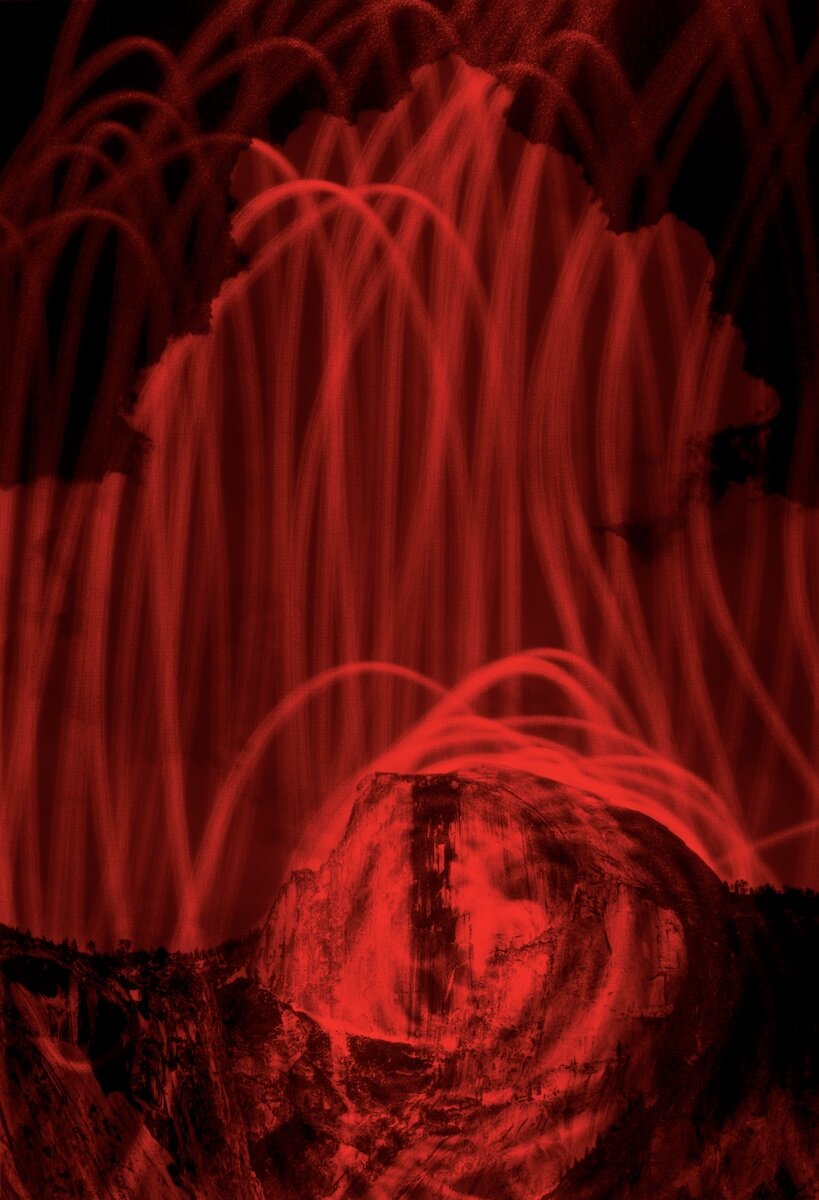Portfolio Three (Red Circles)
There’s red circles in the history of art, an old story of Giotto, sending a hastily drawn though perfect red circle to the Pope, a coded sample, demonstrating technical excellence if only the Pope understands (he does). This an echo of a story from Ancient Greece of two artists vying with the other to draw the most perfect line, each line drawn recursively inside that of the other. There’s Rembrandt, depicting himself in an unusual fashion, as an artist, perfect circles drawn on the blankness behind him.
Here are my red circles, laser-lighted onto an book of Ansel Adams’s images given to me by my mother when I was a teenager, the plates still somewhere in my head all these years later.
[An excerpt from an essay in my my book, Computational Photography.]
He is a famous artist, famous throughout the land. (This story takes place almost two thousand years later.) He lives and works in Florence and, like Apelles, is so renowned that hundreds of years later he is written about, in this case by Giorgio Vasari, with the highest praise. Indeed, Vasari credits Giotto with saving painting as an art from the ruins of war and restoring it to its former glory. His technical skill is sought eagerly within Florence and within nearby Pisa.
One day a man arrives at Giotto’s studio. Giotto is busy working, creating, but the man insists on seeing him. He’s an emissary from Rome, from Pope Benedict.
Giotto’s skill is supreme and unchallenged yet the emissary—Vasari calls him a courtier in the English translation—is from Rome, the center of all things. The man is a man who assumes his social superiority, his greater cultural understanding, not so much because of any demonstration or based upon any comparison with others, but simply assumes it because he is from Rome and not from some lesser place. But yet word had reached Rome of a splendid work by Giotto at the church in Pisa, and so he had been sent there and to other towns to inquire about the local artists, to seek out those suitable to submit samples of their work for a commission at St. Peter’s, the great cathedral at the heart of Christendom.
There is a pause as Giotto pulls back on his instinctual haughtiness, a nearly chemical reaction to this man who thinks himself his better. “I am busy now, come back some other time!” he says, not looking up from his work.
As in the last story, I’m embellishing, painting my own picture.
The emissary, startled, takes his leave, but returns the next day. The studio is cluttered with finished works on the walls and shelves, works-in-progress across all of the tables, assistants buzzing about. The man stands before the artist, telling Giotto that his request is from the Pope, that he is being considered for a lucrative commission at St. Peter’s, that the Pope needs a sample of his work. “Be gone, I am busy,” says Giotto, again dismissing the man.
The third day comes, and again the emissary. He knows that he cannot return to Rome, to the Pope, without a drawing, a small painting, from the most famous artist in the region, one whose reputation figured in the Pope’s initial motivation to charge him with this very errand. He again arrives at Giotto’s studio. He knows the artist does not like him. He again asks for a sample. “Anything, he says, any one of these will do.” He gestures to a number of small studies that sit drying along the wall. “Some little drawing, perhaps.”
Giotto looks up at him from his workbench, his hands still holding his tools. Neither man moves, their eyes meet, gaze is held by gaze. Giotto senses the vexation in the other man, the need to fulfill his obligation put to him by his master. Giotto relents and walks to a canvas, stretching it out vertically upon a stand. He takes up brush and red paint, or perhaps pen and red ink—Vasari prefers the ink, I the paint, but in either case it is red. He stands perpendicular against the blank canvas, his right shoulder nearly against the surface, every muscle tensioned, at the ready. Without a sound he moves, he springs, windmilling his arm around the canvas, articulating a circle so perfect that it is marvelous to all.
“This is your drawing,” he says to the perplexed courtier, tossing it down upon the table.
The emissary moves his face slowly, controlled in his reaction. “Do I understand correctly, I am to have no other drawing but this?” Giotto, looking down at his workbench again, waves him away. Without looking up, he says, “This is enough. Send it with the samples from the other artists. We will see if the Pope understands.”





